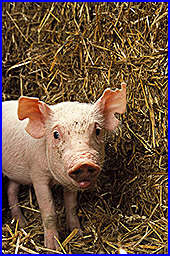



"Herald" Barley Benefits Farm Animals, Growers and Environment
US - Just like people, farm animals need phosphorus to stay healthy. Now, a new barley for feeding to cows, pigs, chickens—and perhaps even farm-raised trout—not only provides this essential nutrient, but does so in a way that helps the environment and barley growers, too. |
| Herald, a new feed barley, may reduce the amount of pollution-causing phosphorus in farm animal manure. |
Agricultural Research Service plant geneticists Phil Bregitzer, Donald Obert and Victor Raboy in Idaho and University of Idaho colleagues Juliet Windes and James Whitmore developed the new, eco-friendly grain.
Named "Herald," it is the first commercial-quality barley that provides a greater proportion of its phosphorus in a bioavailable form—that is, more readily absorbed and used.
That's according to tests conducted by the ARS scientists, all of whom are with the agency's Small Grains and Potato Germplasm Research Unit in Aberdeen, Idaho.
Compared to other top-yielding feed barleys like Baronesse and Colter, Herald had about 10 percent less total phosphorus, but had more than three times as much phosphorus in the bioavailable form.
Bioavailable phosphorus is less likely to end up in animal manure and be carried away by rain runoff from pastures and fields into nearby streams, rivers and lakes, or seep into underground water supplies intended for people to drink.
Superior bioavailability of this nutrient in the novel barley should save growers the cost of feeding phosphorus supplements to farm animals. What's more, Herald barley produces excellent yields. So, growers don't have to sacrifice quantity to take advantage of the unique barley's pollution-lessening trait.
Herald barley is the latest addition to a line of crops—including corn, rice and soybeans—that are low in the hard-to-digest or, for some animals, completely indigestible form of phosphorus known as phytic acid. These low-phytic-acid feeds build upon earlier work in which Raboy used conventional plant-breeding procedures to chemically tweak seeds' phosphorus makeup, resulting in the prized, low-phytic-acid trait.
Seed companies and plant researchers can acquire supplies of Herald seed from the Foundation Seed Program at Kimberly, Idaho.
ThePoultrySite News Desk








